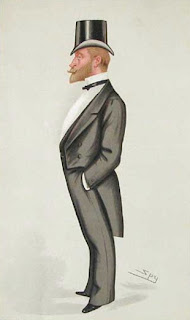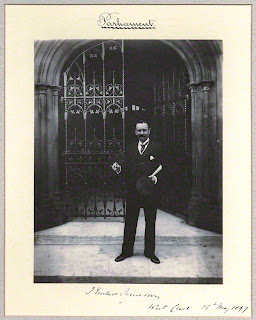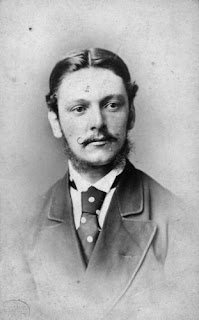In 1892, Russell was involved in promoting a railway in London, between Royal Exchange and Waterloo.
An article in The Electrical Engineer of January I, 1892 titled, New Electric Railways For London described a number of proposals introducing them as follows:
‘The comparative success of the existing electric railway in London has evidently given an impetus to the movement for providing still further means of locomotion of a similar kind. For consideration during the forthcoming session of Parliament there are no fewer than five Bills which propose either the construction of new electric railways or the extension of lines already authorised.’
The full article is here . Among the schemes it describes are:
Great Northern and City Railway
A proposal for the incorporation of a new company with powers to construct a line of railway from the Canonbury branch of the Great Northern line near Finsbury Park to the City.
Islington and the City
The City and South London Railway Company, a Bill repeating their proposal of 1891 for the construction of a line extending their system to The Angel, at Islington.
Central London Railway
A proposal to extend their powers by the making of a line from under Mansion House Street, near the junction with Queen Victoria Street, to the Liverpool Street Station of the Great Eastern Railway Company.
Baker Street and Waterloo
There are no less than three new railways projected from and to Waterloo, one of which is an underground railway to be worked by electricity.
Royal Exchange and Waterloo
‘In addition to the intended Waterloo and City Electric Railway, it was also proposed to extend the London and South Western and London, Brighton, and South Coast Railways to a terminus in the City, for which purpose it is sought to incorporate a new company, consisting, among others, of the Hon. F. S. A. Hanbury-Tracy, Major John Eustace Jameson, Mr. Campbell Praed, and Mr. James Cholmeley Russell, with a capital of £2,700,000, divided into 270,000 £10 shares.
'Junctions would be formed with the main, Windsor, and other lines of the London and South-Western Company at Waterloo Station, and with the London, Brighton, and South Coast Railway in the parish of St. John, Horseleydown, where it crosses Bermondsey Street by means of a bridge; and the new lines would run by way of Southwark Street to a point in the City close to the junction of Crooked Lane with Arthur Street, crossing the Thames by means of a bridge, in connection with which a free public footway would be constructed. Three years is the time fixed for the compulsory acquirement of land, and five years for the completion of the works. It is also sought to enter into working agreements with the London and South Western and the London, Brighton, and South Coast Companies, and to pay interest out of capital during construction.'
James Szlumper was to have been the engineer. The line was never constructed
The Engineer magazine of 4th December 1892 illustrated the proposals as follows:
The Engineer magazine of 4th December 1892 illustrated the proposals as follows:
 |
| Proposed Waterloo and Royal Exchange Railway |
The magazine commented as follows:
Southwark St John Horsleydown was a small parish on the south bank of the River Thames in London, opposite the Tower of London.
'So much interest attaches to the projects for railways from Waterloo
'This project must be distinguished
from the proposed tunnel from Waterloo to near the mansion House, which has the
objection that the passengers will have to be taken down to the proposed deep
tunnel by a lift from Waterloo station and thence under the River Thames; and when
the Mansion is reached another lift will be required to take the passengers up
to the surface. Besides the unpleasantness of travelling in a tunnel, the
scheme entails no less than three changes for the passengers.
'The other scheme,
of which we give a route map, is called the Royal Exchange and Waterloo
Railway. It will have four lines of rails, and has the distinct advantage of
being above ground. Mr J W Szlumper MInst.C.E is the engineer of the scheme and
proposes to construct a continuous and unbroken line of railway from Waterloo Station to the City, so that the
London and South Western Company’s engines and carriages would after calling at
Waterloo, proceed direct to the City above ground for the whole distance. It
will be seen from the map that the scheme also contemplates a line from London
Bridge Station of the Brighton Company to the City, a most important facility. Another
feature in this scheme is the construction of a free public footway over a new
bridge proposed to be erected across the Thames, and which it would it is
believed considerably relieve London
Bridge
Southwark St John Horsleydown was a small parish on the south bank of the River Thames in London, opposite the Tower of London.
In the metropolitan re-organisation of 1855 it was grouped into the St Olave District. The civil parish became part of the Metropolitan Borough of Bermondsey in 1900 when the St Olave District was abolished, and in 1904 Southwark St John Horsleydown was absorbed into the Bermondsey parish. Since 1965 it has formed part of the London Borough of Southwark (Wikipedia)
In addition to Russell, the promoters were the following gentlemen:
F. S. A. Hanbury-Tracy was the Hon. Frederick Stephen Archibald Hanbury-Tracy (1848 - 1906), a younger son of Thomas Hanbury-Tracy, 2nd Baron Sudeley, and his wife Emma Elizabeth Alicia, daughter of George Hay Dawkins Pennant. Charles Hanbury-Tracy, 4th Baron Sudeley, was his elder brother. He succeeded the latter as Member of Parliament for Montgomery in 1877, a seat he held until 1885, and again from 1886 to 1892.
Hanbury Tracy lived at 116 Queens Gate, South Kensington, Russell living at 86 Queen’s Gate for several years in the 1880s and 1890s
Major John Eustace Jameson (1853-1919 was a politician, businessman and Army officer. He was the MP for West Clare and at one time was a factory inspector. He was the subject of both a photographic portrait now in the National Portrait Gallery collection and a Spy cartoon ‘The Major from Clare’
Campbell Praed was Arthur Campbell Bulkley Mackworth-Praed (1846–1901), the husband of the Australian novelist, Rosa Campbell Praed. He was a member of an English banking and brewing family. For more on the Campbell Praed brewing family see The Brewing Industry: A Guide to Historical Records edited by L. M. Richmond, Alison Turton


